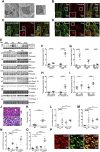Fibin regulates cardiomyocyte hypertrophy and causes protein-aggregate-associated cardiomyopathy in vivo
- PMID: 37342207
- PMCID: PMC10278231
- DOI: 10.3389/fmolb.2023.1169658
Fibin regulates cardiomyocyte hypertrophy and causes protein-aggregate-associated cardiomyopathy in vivo
Abstract
Despite the identification of numerous molecular pathways modulating cardiac hypertrophy its pathogenesis is not completely understood. In this study we define an unexpected role for Fibin ("fin bud initiation factor homolog") in cardiomyocyte hypertrophy. Via gene expression profiling in hypertrophic murine hearts after transverse aortic constriction we found a significant induction of Fibin. Moreover, Fibin was upregulated in another mouse model of cardiac hypertrophy (calcineurin-transgenics) as well as in patients with dilated cardiomyopathy. Immunoflourescence microscopy revealed subcellular localization of Fibin at the sarcomeric z-disc. Overexpression of Fibin in neonatal rat ventricular cardiomyocytes revealed a strong anti-hypertrophic effect through inhibiting both, NFAT- and SRF-dependent signalling. In contrast, transgenic mice with cardiac-restricted overexpression of Fibin developed dilated cardiomyopathy, accompanied by induction of hypertrophy-associated genes. Moreover, Fibin overexpression accelerated the progression to heart failure in the presence of prohypertrophic stimuli such as pressure overload and calcineurin overexpression. Histological and ultrastructural analyses surprisingly showed large protein aggregates containing Fibin. On the molecular level, aggregate formation was accompanied by an induction of the unfolded protein response subsequent UPR-mediated apoptosis and autophagy. Taken together, we identified Fibin as a novel potent negative regulator of cardiomyocyte hypertrophy in vitro. Yet, heart-specific Fibin overexpression in vivo causes development of a protein-aggregate-associated cardiomyopathy. Because of close similarities to myofibrillar myopathies, Fibin represents a candidate gene for cardiomyopathy and Fibin transgenic mice may provide additional mechanistic insight into aggregate formation in these diseases.
Keywords: NFAT signalling; SRF signalling; cardiac hypertrophy; cardiac z-disc; fibin; protein aggregate associated cardiomyopathy.
Copyright © 2023 Petersen, Schmiedel, Dierck, Hille, Remes, Senger, Schmidt, Lüllmann-Rauch, Müller, Frank, Rangrez, Frey and Kuhn.
Conflict of interest statement
The authors declare that the research was conducted in the absence of any commercial or financial relationships that could be construed as a potential conflict of interest.
Figures







Similar articles
-
Mice with cardiac-restricted overexpression of Myozap are sensitized to biomechanical stress and develop a protein-aggregate-associated cardiomyopathy.J Mol Cell Cardiol. 2014 Jul;72:196-207. doi: 10.1016/j.yjmcc.2014.03.016. Epub 2014 Mar 31. J Mol Cell Cardiol. 2014. PMID: 24698889
-
The novel cardiac z-disc protein CEFIP regulates cardiomyocyte hypertrophy by modulating calcineurin signaling.J Biol Chem. 2017 Sep 15;292(37):15180-15191. doi: 10.1074/jbc.M117.786764. Epub 2017 Jul 17. J Biol Chem. 2017. PMID: 28717008 Free PMC article.
-
Lmcd1/Dyxin, a novel Z-disc associated LIM protein, mediates cardiac hypertrophy in vitro and in vivo.J Mol Cell Cardiol. 2010 Oct;49(4):673-82. doi: 10.1016/j.yjmcc.2010.06.009. Epub 2010 Jun 30. J Mol Cell Cardiol. 2010. PMID: 20600098
-
A gene therapeutic approach to inhibit calcium and integrin binding protein 1 ameliorates maladaptive remodelling in pressure overload.Cardiovasc Res. 2019 Jan 1;115(1):71-82. doi: 10.1093/cvr/cvy154. Cardiovasc Res. 2019. PMID: 29931050
-
Decreased KCNE2 Expression Participates in the Development of Cardiac Hypertrophy by Regulation of Calcineurin-NFAT (Nuclear Factor of Activated T Cells) and Mitogen-Activated Protein Kinase Pathways.Circ Heart Fail. 2017 Jun;10(6):e003960. doi: 10.1161/CIRCHEARTFAILURE.117.003960. Circ Heart Fail. 2017. Retraction in: Circ Heart Fail. 2017 Nov;10(11):e000024. doi: 10.1161/HHF.0000000000000024. PMID: 28611128 Retracted.
Cited by
-
Identification of a DNA methylation episignature for recurrent constellations of embryonic malformations.Am J Hum Genet. 2024 Aug 8;111(8):1643-1655. doi: 10.1016/j.ajhg.2024.07.005. Epub 2024 Jul 31. Am J Hum Genet. 2024. PMID: 39089258 Free PMC article.
-
Rivaroxaban versus enoxaparin plus clopidogrel therapy for hypertrophic cardiomyopathy-associated thromboembolism in cats.Vet World. 2024 Apr;17(4):796-803. doi: 10.14202/vetworld.2024.796-803. Epub 2024 Apr 10. Vet World. 2024. PMID: 38798301 Free PMC article.
References
LinkOut - more resources
Full Text Sources
Miscellaneous

